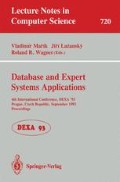Abstract
Given the large number of conceptual schema design tools and methodologies in use today, conversion efforts need strategies by which any source schemas can be easily integrated in heterogeneous database systems. We discuss the design and analysis of strategies for multiple schema/view integration with an extensible redesign system that is object-based, as defined herein. Our focus is on well-defined, clearly identifiable objects; E-R schemas describable in linear form, or in graphical (E-R Diagram) form with annotations. E-R schemas are a composite class of basic objects: E-sets (of entities) and R-sets (of relationships), each of which is extended. E-sets are described by structured sets of keys, lists of attributes (with domains), indexes, and textual constraints. R-sets are structured lists of E-set names with a description of their participation in the R-set [“one” or “many”], and textual constraints, e.g. foreign keys. We propose a design for the missing step: a Graphic Schema Algebra to merge various conceptual schemas, to provide a leverage point for interoperation.
Preview
Unable to display preview. Download preview PDF.
References
Batini, C. and Lenzerini, M. 1984 Amethodology for data schema integration into the entity-relationship model. IEEE Trans. Soitware Engr., SE-10, 6 (Nov) 628–644.
Batini, C., Lenzerini, M. & Navathe, S. A comparative analysis of methodologies for database schema integration, ACM Computing Surveys, v. 15, no.4, Dec. 1986, 323–364.
Casanova,M., Tucherman,L. & Laender,A. Algorithms for designing and maintaining optimized relational repre-sentations of ER schemas, Proc. 9th Intl. Conf. ER Approach Lausanne, 1990,361–374.
Casanova,M. & Vidal,V. Towards a sound view integration methodology, Proc. 2nd ACM SIGMOD-SIGACT Symp. on Prin. DB Systems, Atlanta, March 1983, 36–47.
Chen, P. The Entity-Relationship Model: Toward a Unified View of Data, ACM Trans Database Systems, Vol. 1(1), March 1976, 9–36.
ElMasri,R., Larson,J. & Navathe,S. Integratedalgo-rithms for federated data bases and logical database design. Tech. Report, Honeywell Corp. Research Center, 1987.
Elmasri,R. & Wiederhold, G., Data model inte-gration using the structural model, Proc. ACM SIGMOD Intl. Conf. Mgt. of Data, Boston, June 1979, 191–202.
Jajodia, S., Ng, P. & Springsteel, F., The problem of equivalence for Entity-relationship Diagrams, IEEE Trans. on Software Engr., SE-9, 5, (Sept. 1983), 617–630.
Landers.T. & Rosenberg,R. An overview of MULTIBASE, in: Distributed Databases, H.J. Schneider, ed., North-Holland.
Mannino,M. & Effelsberg,W., 1984. A methodology for global schema design. Tech. report No. TR-84-1, Univ. Florida Comp. & Info. Sci. Dept., Sept. 1984.
Makowsky,J., Markowitz,V. & Rotics,N., Entity-Relationship Consistency for Relational Schemas, Proc. 1st Intl. Conf. Database Theory, Rome, Sept. 1986, 18pp. (pre-print)
Navathe,S. & Gadgil,S. 1982. A methodology for view integration in logical database design, Proc. 8th Intl Conf. on VLDB, Saratoga, CA.
Parent, C.& Spaccapietra, S., View Integration: A step forward in soving structural conflicts, research report, LBD, Dept. Inform., EPFL, Lausanne-Ecublens, Suisse, 1990.
Springsteel,F. & Chuang,P. ERDDS: the intelligent E-R-based Database Design System, Proc. 7th Intl. Conf. on E-R Approach, 1988, Rome, Italy, 211–230.
Springsteel,F. & Kou,C. Reverse Data Engineering of E-R-Designed Relational Schemas, PARBASE-90: Two-track Conf. on Databases, Parallel Architectures, and their Applications, Miami Beach, Florida, March 1990, 438–440.
Smith, J. & Smith, D. 1977. Databse abstraction: aggregation and generaliztion, ACM Trans. Database Sys. 2, 2 (June 1977), 105–133.
Teorey, T., Yang, D. & Fry, J. A logical design methodology for relational databases using the extended entity-relationship model, ACM Computing Surveys. 18, 2, (June 1986), 197–222.
Ullman, J.D., Principles of Database and Knowledge-Base Systems. Vol.1, Computer Science Press, 1988.
Elmasri, R. & Wiederhold, G., Data model integration using the structural model, Proc. ACM SIGMOD Intl. Conf. Mgt. of Data, Boston, June 1979, 191–202.
Woelk,D., Kim,W. & Luther,W. 1986. AN object-oriented approach to the multimedia databases, Proc. ACM SIGMOD Intl. Conf. Mgt. of Data, Washington.
Yao,B., Waddle,Y. & Housel,B. View modeling and integration using the functional data model, IEEE Trans. on Software Enor., SE-8,6, 544–553.
Author information
Authors and Affiliations
Editor information
Rights and permissions
Copyright information
© 1993 Springer-Verlag Berlin Heidelberg
About this paper
Cite this paper
Springsteel, F.N. (1993). Object-based schema integration for heterogeneous databases: A logical approach. In: Mařík, V., Lažanský, J., Wagner, R.R. (eds) Database and Expert Systems Applications. DEXA 1993. Lecture Notes in Computer Science, vol 720. Springer, Berlin, Heidelberg. https://doi.org/10.1007/3-540-57234-1_15
Download citation
DOI: https://doi.org/10.1007/3-540-57234-1_15
Published:
Publisher Name: Springer, Berlin, Heidelberg
Print ISBN: 978-3-540-57234-3
Online ISBN: 978-3-540-47982-6
eBook Packages: Springer Book Archive

